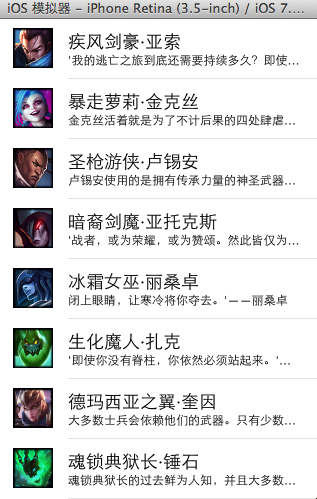IOS 陀螺儀開發(CoreMotion框架)實例詳解
iOS陀螺儀 參數意義
self.mManager = [[CMMotionManager alloc]init];
self.mManager.deviceMotionUpdateInterval = 0.5;
if (self.mManager.gyroAvailable) {
[self.mManager startDeviceMotionUpdatesToQueue:[NSOperationQueue currentQueue] withHandler:^(CMDeviceMotion * _Nullable motion, NSError * _Nullable error) {
NSLog(@"RotationRate X:%.2lf Y:%.2lf Z:%.2lf ",motion.userAcceleration.x,motion.userAcceleration.y,motion.userAcceleration.z);
}];
}
x軸 頭 靠近 負數 Y參數
x軸 頭 遠離 正數
y軸 左側 高 正數 X參數
y軸 右側 高 負數
下面介紹下 CoreMotion框架
CoreMotion是一個專門處理Motion的框架,其中包含了兩個部分加速度計和陀螺儀,在iOS4之前加速度計是由UIAccelerometer類來負責采集數據,現在一般都是用CoreMotion來處理加速度過程,不過由於UIAccelerometer比較簡單,同樣有人在使用。加速計由三個坐標軸決定,用戶最常見的操作設備的動作移動,晃動手機(搖一搖),傾斜手機都可以被設備檢測到,加速計可以檢測到線性的變化,陀螺儀可以更好的檢測到偏轉的動作,可以根據用戶的動作做出相應的動作,iOS模擬器無法模擬以上動作,真機調試需要開發者賬號。
加速計
加速計的x,y,z三個方向,參考下圖:

如果只需要知道設備的方向,不需要知道具體方向矢量角度,那麼可以使用UIDevice進行操作,還可以根據方向就行判斷,具體可以參考一下蘋果官網代碼:
-(void) viewDidLoad {
// Request to turn on accelerometer and begin receiving accelerometer events
[[UIDevice currentDevice] beginGeneratingDeviceOrientationNotifications];
[[NSNotificationCenter defaultCenter] addObserver:self selector:@selector(orientationChanged:) name:UIDeviceOrientationDidChangeNotification object:nil];
}
- (void)orientationChanged:(NSNotification *)notification {
// Respond to changes in device orientation
}
-(void) viewDidDisappear {
// Request to stop receiving accelerometer events and turn off accelerometer
[[NSNotificationCenter defaultCenter] removeObserver:self];
[[UIDevice currentDevice] endGeneratingDeviceOrientationNotifications];
}
當用戶晃動設備的時候,系統會通知每一個在用的設備,可以使本身成為第一響應者:
- (BOOL)canBecomeFirstResponder {
return YES;
}
- (void)viewDidAppear:(BOOL)animated {
[self becomeFirstResponder];
}
處理Motion事件有三種方式,開始(motionBegan),結束(motionEnded),取消(motionCancelled):
- (void)motionBegan:(UIEventSubtype)motion withEvent:(UIEvent *)event NS_AVAILABLE_IOS(3_0); - (void)motionEnded:(UIEventSubtype)motion withEvent:(UIEvent *)event NS_AVAILABLE_IOS(3_0); - (void)motionCancelled:(UIEventSubtype)motion withEvent:(UIEvent *)event NS_AVAILABLE_IOS(3_0);
motionEnded方法中處理:
- (void)motionEnded:(UIEventSubtype)motion withEvent:(UIEvent *)event {
if (motion == UIEventSubtypeMotionShake)
{
// FlyElephant http://www.cnblogs.com/xiaofeixiang
[[NSNotificationCenter defaultCenter] postNotificationName:@"FlyElephant" object:self];
}
}
CoreMotion在處理加速計數據和陀螺儀數據的時是一個非常重要的框架,框架本身集成了很多算法獲取原生的數據,而且能很好的展現出來,CoreMotion與UIKit不同,連接的是UIEvent而不是事件響應鏈。CoreMotion相對於接收數據只是更簡單的分發motion事件。
CMMotionManager類能夠使用到設備的所有移動數據(motion data),Core Motion框架提供了兩種對motion數據的操作方式:
pull方式:能夠以CoreMotionManager的只讀方式獲取當前任何傳感器狀態或是組合數據;
push方式:是以塊或者閉包的形式收集到想要得到的數據並且在特定周期內得到實時的更新;
pull處理方式:
//判斷加速計是否可用
if ([_motionManager isAccelerometerAvailable]) {
// 設置加速計采樣頻率
[_motionManager setAccelerometerUpdateInterval:1 / 40.0];
[_motionManager startAccelerometerUpdates];
} else {
NSLog(@"博客園-FlyElephant");
}
觸摸結束:
-(void)touchesEnded:(NSSet *)touches withEvent:(UIEvent *)event{
CMAcceleration acceleration=_motionManager.accelerometerData.acceleration;
NSLog(@"%f---%f---%f",acceleration.x,acceleration.y,acceleration.z);
}
push處理方式:
@property (strong,nonatomic) CMMotionManager *motionManager; @property (strong,nonatomic) NSOperationQueue *quene; _motionManager=[[CMMotionManager alloc]init];
//判斷加速計是否可用
if ([_motionManager isAccelerometerAvailable]) {
// 設置加速計頻率
[_motionManager setAccelerometerUpdateInterval:1 / 40.0];
//開始采樣數據
[_motionManager startAccelerometerUpdatesToQueue:_quene withHandler:^(CMAccelerometerData *accelerometerData, NSError *error) {
NSLog(@"%f---%f",accelerometerData.acceleration.x,accelerometerData.acceleration.y);
}];
} else {
NSLog(@"博客園-FlyElephant");
}
時間設置頻率:

陀螺儀
陀螺儀其實主要方法和方式和加速計沒有區別,先看張陀螺儀旋轉的角度圖片:

陀螺儀更新數據也有兩種方式,pull方式(startGyroUpdates),push方式(startGyroUpdatesToQueue):
static const NSTimeInterval gyroMin = 0.01;
- (void)startUpdatesWithSliderValue:(int)sliderValue {
// Determine the update interval
NSTimeInterval delta = 0.005;
NSTimeInterval updateInterval = gyroMin + delta * sliderValue;
// Create a CMMotionManager
CMMotionManager *mManager = [(APLAppDelegate *)[[UIApplication sharedApplication] delegate] sharedManager];
APLGyroGraphViewController * __weak weakSelf = self;
// Check whether the gyroscope is available
if ([mManager isGyroAvailable] == YES) {
// Assign the update interval to the motion manager
[mManager setGyroUpdateInterval:updateInterval];
[mManager startGyroUpdatesToQueue:[NSOperationQueue mainQueue] withHandler:^(CMGyroData *gyroData, NSError *error) {
[weakSelf.graphView addX:gyroData.rotationRate.x y:gyroData.rotationRate.y z:gyroData.rotationRate.z];
[weakSelf setLabelValueX:gyroData.rotationRate.x y:gyroData.rotationRate.y z:gyroData.rotationRate.z];
}];
}
self.updateIntervalLabel.text = [NSString stringWithFormat:@"%f", updateInterval];
}
- (void)stopUpdates{
CMMotionManager *mManager = [(APLAppDelegate *)[[UIApplication sharedApplication] delegate] sharedManager];
if ([mManager isGyroActive] == YES) {
[mManager stopGyroUpdates];
}
}
感謝閱讀,希望能幫助到大家,謝謝大家對本站的支持!
- 上一頁:iOS 檢測網絡狀態的兩種方法
- 下一頁:IOS 實現搖一搖的操作




